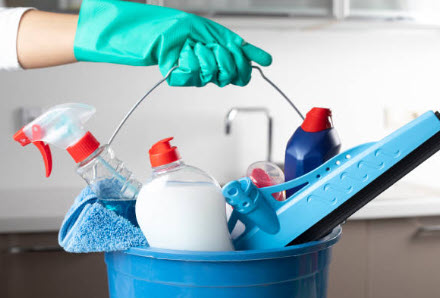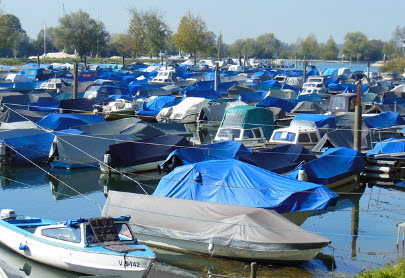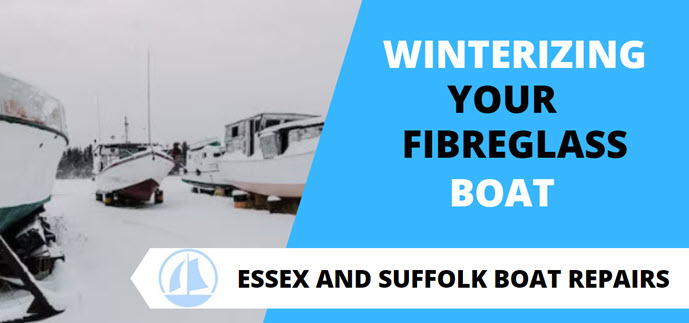As winter approaches, boat owners are faced with a crucial task – preparing their vessels for the colder months. In this blog post, we’ll explore the necessity and significance of winterizing your fibreglass boat. Beyond just a seasonal chore, proper winterization is a key factor in extending the life and maintaining the performance of your cherished watercraft.
Table of Contents
Understanding the Necessity
Winterization is not merely a precautionary measure; it is a fundamental aspect of responsible boat ownership. The frigid temperatures and harsh conditions of winter can take a toll on your fibreglass boat, potentially leading to a host of issues that can compromise its structural integrity and functionality.
Extending the Life and Performance
By taking the time to winterize your boat, you are essentially investing in its long-term health. The process goes beyond safeguarding against immediate damage – it contributes to the overall well-being of your vessel. Properly winterized boats often exhibit extended lifespans and consistently superior performance when compared to those that have not undergone this essential procedure.
Consequences of Neglect
To highlight the significance of winterization, it’s essential to understand the potential consequences of neglecting this vital step. Without proper preparation, your boat becomes susceptible to a range of issues, including but not limited to freezing damage, corrosion, and engine problems.
The financial and emotional costs of addressing these issues in the spring can far outweigh the relatively small investment of time and effort required for winterization.
In the following sections, we’ll delve into the specifics of winterizing fibreglass boats, providing you with a comprehensive guide to ensure that your vessel not only weathers the winter months but emerges ready for smooth sailing in the spring.
Understanding Your Boat: Fibreglass 101
Fibreglass boats are renowned for their durability, lightweight construction, and versatility on the water. To effectively winterize your vessel, it’s crucial to comprehend both the unique strengths and vulnerabilities that come with this material.
Unique Characteristics
Durability: Fibreglass boats are celebrated for their robust construction, offering a high strength-to-weight ratio. This makes them resilient against various impacts and stresses encountered during regular use.
Lightweight Design: The inherent lightweight nature of fibreglass contributes to enhanced fuel efficiency and manoeuvrability. It also makes these boats popular among boaters who value speed and agility.
Versatility: Fibreglass allows for versatile hull designs, accommodating different boat types from sleek powerboats to sturdy sailboats. This versatility makes fibreglass a preferred choice for boat builders.
Strengths and Vulnerabilities
Strengths:
- Corrosion Resistance: Unlike metal boats, fibreglass is not susceptible to rust, providing an advantage in terms of longevity.
- Smooth Surface Finish: Fibreglass boats often boast a smooth and glossy finish, contributing to their aesthetic appeal and ease of maintenance.
Vulnerabilities:
- Gelcoat Damage: The outer layer of fibreglass, known as the gelcoat, is susceptible to damage from impacts, abrasions, and prolonged exposure to the elements.
- Water Absorption: Over time, fibreglass can absorb water if not properly sealed, potentially leading to structural issues and delamination.
Special Care for Winterization

Given the unique characteristics of fibreglass, it demands special care during winterization:
- Gelcoat Protection: Applying a high-quality wax or protective coating before winter helps safeguard the gelcoat from the harsh winter elements and minimizes the risk of damage.
- Sealing Vulnerable Areas: Paying close attention to potential water entry points, such as fittings and joints, is crucial. Properly sealing these areas helps prevent water intrusion that can lead to structural problems.
- Avoiding Abrasives: When cleaning, use non-abrasive cleaning materials to avoid scratching or damaging the smooth surface of the fibreglass.
Impact of Winter Conditions on Fibreglass Material
Winter conditions can pose specific challenges to fibreglass boats:
- Freezing Temperatures: Fibreglass can contract and expand with temperature fluctuations. In freezing conditions, this movement can lead to cracks or delamination if not properly addressed.
- Moisture Absorption: Fibreglass that has not been adequately sealed can absorb moisture, which may freeze and expand, causing structural damage.
Understanding these characteristics, strengths, vulnerabilities, and the impact of winter conditions is fundamental to tailoring an effective winterization strategy for your fibreglass boat. In the next section, we’ll delve into the detailed steps for cleaning and inspecting your boat to ensure a thorough winterization process.
Guide to Cleaning and Inspection: The First Steps to Winterize
Before delving into the specific winterization procedures, it’s essential to commence the process with a thorough cleaning and inspection of your fibreglass boat. This initial step lays the foundation for a successful winterization and ensures that potential issues are identified and addressed promptly.
Proper Cleaning Steps:
- Exterior Cleaning:
- Begin by rinsing the boat with fresh water to remove salt, dirt, and other debris.
- Use a mild detergent or boat wash specifically designed for fibreglass to clean the hull, deck, and superstructure.
- Pay attention to the gelcoat, gently scrubbing with a soft sponge or brush to avoid scratches.
- Interior Cleaning:
- Remove all personal items and equipment from the boat.
- Thoroughly clean the interior, including seating, storage compartments, and any appliances, using appropriate cleaning products.
- Canvas and Upholstery:
- Clean canvas covers and upholstery with specialized cleaners suitable for the material.
- Ensure these components are completely dry before storing to prevent mold and mildew growth.
- Metal and Hardware:
- Use metal polish on stainless steel or chrome fixtures to prevent corrosion.
- Inspect hardware for signs of wear and tighten any loose fittings.
Recommended Cleaning Supplies and Equipment:

- Boat Wash or Mild Detergent: Choose a product specifically formulated for fibreglass to avoid damaging the gelcoat.
- Soft Sponge or Brush: Use non-abrasive tools to clean the boat’s surfaces, preventing scratches.
- Canvas and Upholstery Cleaner: Select cleaners designed for the specific materials used in your boat’s interior.
- Metal Polish: Protect metal fixtures from corrosion with a suitable polish.
- Fresh Water Hose: Rinse the boat thoroughly to remove salt and other contaminants.
Areas of Wear and Tear to Inspect:
- Gelcoat:
- Look for cracks, chips, or areas where the gelcoat may be compromised.
- Inspect for fading or discoloration, which could indicate sun damage.
- Seams and Joints:
- Check for any separation or damage in seams and joints, especially around hatches and fittings.
- Hull and Keel:
- Examine the hull and keel for any signs of impact damage, including scratches or dents.
- Rub Rail and Trim:
- Inspect the rub rail and trim for secure attachment and any signs of wear.
- Electrical Components:
- Check all electrical components for corrosion or loose connections.
- Through-Hull Fittings:
- Inspect through-hull fittings for leaks or damage.
By thoroughly cleaning and inspecting your fibreglass boat, you set the stage for a comprehensive winterization process. In the next section, we’ll delve into critical steps involving draining, sealing, and managing moisture to protect your boat during the winter months.
Critical Steps to Take: Draining, Sealing, and Managing Moisture
As winter approaches, the focus shifts from cleaning and inspecting to the critical steps of draining, sealing, and managing moisture within your fibreglass boat. These steps are paramount in safeguarding your vessel against freeze damage and ensuring it emerges from winterization unscathed.
1. Draining:
Begin by systematically draining water from various components:
- Bilge Area: Ensure the bilge is completely dry. Use a bilge pump or sponge to remove any residual water.
- Engine Cooling System: Follow the manufacturer’s guidelines to drain the engine cooling system to prevent freezing.
- Water Tanks and Plumbing: Empty water tanks and drain plumbing systems to prevent damage from frozen water.
2. Sealing Vulnerable Areas:
Prevent moisture intrusion by focusing on vulnerable points:
- Hatches and Ports: Check and reseal hatches and ports to prevent water ingress.
- Fittings and Joints: Inspect fittings and joints for any signs of wear or damage. Apply marine sealant as needed to ensure a watertight seal.
- Windows and Windshields: Check window seals and windshield gaskets for any deterioration. Replace or reseal as necessary.
3. Managing Moisture:
Moisture management is crucial for preventing freeze damage and maintaining the structural integrity of your fibreglass boat:
- Use Desiccants: Place desiccant bags in enclosed spaces to absorb excess moisture.
- Ventilation: Allow for proper ventilation by leaving cabin doors and compartments slightly open. This helps prevent the buildup of condensation.
- Bilge Ventilation: Install a bilge ventilation system to ensure air circulation, reducing the risk of mold and mildew.
How These Steps Reduce Freeze Damage:

- Preventing Freezing of Residual Water: By diligently draining all water from the bilge, engine, and plumbing, you eliminate the risk of residual water freezing and causing damage.
- Avoiding Expansion and Contraction: Sealing vulnerable areas and managing moisture prevents water from entering the boat’s structure. This minimizes the risk of freezing, expansion, and contraction that could lead to cracks or delamination.
Tips on Selecting the Right Products:
- Marine Sealant: Choose a high-quality marine sealant suitable for fibreglass to ensure a reliable and long-lasting seal on vulnerable areas.
- Desiccants: Select desiccant products designed for marine use, and strategically place them in enclosed spaces to absorb excess moisture.
- Bilge Pump and Ventilation System: Invest in a reliable bilge pump and ventilation system that meets the specific needs of your boat, ensuring efficient water removal and air circulation.
Taking these critical steps will not only protect your fibreglass boat from freeze damage but also contribute to its overall resilience against the harsh winter elements. In the next section, we’ll delve into the importance of proper storage and provide guidance on selecting covers, tarps, and storage techniques tailored for fibreglass boats.
Proper Storage of Your Fibreglass Boat: Protecting Your Investment
As winterization enters its final phase, the importance of proper storage cannot be overstated. The way you store your fibreglass boat during the winter months plays a pivotal role in safeguarding its structural integrity and ensuring a smooth transition back to the water in spring. Let’s explore different storage options, their pros and cons, and offer guidance on selecting covers, tarps, and storage techniques tailored for fibreglass boats.
Different Storage Options:
- Indoor Storage:
- Pros: Provides the highest level of protection from the elements, minimizing exposure to harsh weather conditions.
- Cons: Indoor storage facilities can be more expensive, and availability may be limited.
- Outdoor Storage with Shrink Wrap:
- Pros: Shrink wrap provides a tight and protective covering, preventing snow and water from accumulating on the boat.
- Cons: It can be relatively more expensive than other outdoor storage methods, and ventilation may be a concern.
- Covered Boat Slips or Docks:
- Pros: Offers a good compromise between indoor and outdoor storage, providing overhead coverage.
- Cons: Exposure to the sides leaves the boat susceptible to wind-driven rain and snow.
- Trailered Storage:
- Pros: Allows for flexibility in choosing different storage locations. Trailers with adjustable supports can protect the hull.
- Cons: The boat is still exposed to the elements, and additional measures are needed to cover and secure it effectively.
Guidance on Covers, Tarpaulins, and Storage Techniques:

- Boat Covers:
- Choose a custom-fit boat cover made from marine-grade materials designed for fibreglass boats.
- Ensure the cover is breathable to prevent condensation buildup and mildew.
- Tarpaulins and Shrink Wrap:
- Use high-quality, UV-resistant tarps or shrink wrap to create a protective barrier against snow, rain, and UV rays.
- Ensure proper ventilation to prevent moisture buildup.
- Support Structures:
- Use boat stands or supports designed for fibreglass boats to distribute weight evenly and avoid stress points.
- Place padding between the boat and any support structures to prevent abrasions.
- Dehumidifiers:
- Consider using dehumidifiers or moisture-absorbing products within the boat to control humidity levels and prevent mold growth.
Importance of a Well-Planned Storage Strategy:
- Preventing Structural Damage:
- A well-planned storage strategy minimizes the risk of structural damage by protecting the boat from the weight of snow, ice, and water.
- Preserving Aesthetics:
- Proper storage helps maintain the aesthetic appeal of your fibreglass boat by preventing fading, discoloration, and damage to the gelcoat.
- Avoiding Mold and Mildew:
- Adequate ventilation and moisture control are essential in preventing the growth of mold and mildew during the winter months.
- Easy Spring Launch:
- A thoughtfully stored boat requires less preparation when it’s time to launch in the spring, ensuring a smoother transition back to the water.
In conclusion, the success of your winterization efforts hinges on the storage choices you make. By carefully considering different storage options, utilizing suitable covers and tarps, and implementing proper storage techniques, you’re not only protecting your investment but also setting the stage for a hassle-free return to the water when warmer days arrive. In the final section, we’ll wrap up with concluding thoughts and a reminder to plan ahead for the spring sailing season.
Concluding Thoughts: Sailing Smoothly into Spring
As we conclude this guide on winterizing your fibreglass boat, it’s crucial to underscore the profound impact that thorough winterization can have on the longevity and efficiency of your vessel.
The efforts invested in cleaning, inspecting, draining, sealing, and strategically storing your boat during the winter months are not merely precautions but essential steps in preserving your investment.
Benefits of Thorough Winterization:
- Extended Longevity: Proper winterization significantly extends the lifespan of your fibreglass boat, ensuring it remains seaworthy for years to come.
- Optimized Performance: By safeguarding against freeze damage, structural issues, and other potential problems, you’re setting the stage for optimal performance when you return to the water in the spring.
- Preservation of Aesthetics: Thorough winterization helps maintain the aesthetic appeal of your boat, protecting against fading, discoloration, and other cosmetic concerns.
Importance of Meticulous Execution:
The effectiveness of winterization hinges on attention to detail and meticulous execution of each step. Neglecting even a small aspect of the process could leave your boat vulnerable to winter-related damage. Take the time to follow each guideline carefully, ensuring no corner is cut in the pursuit of comprehensive winter protection.
Looking Ahead to Spring:

As you navigate through the winter months, consider looking ahead to the spring sailing season. Planning for a smooth transition involves more than just winterization; it requires foresight and preparation:
- Schedule Post-Winter Servicing: Plan ahead by scheduling any necessary servicing or maintenance work for your boat post-winter. This proactive approach allows you to address any issues that may have arisen during the colder months and ensures your boat is in top condition for the upcoming season.
- Check Your Calendar: Mark important dates on your calendar for tasks such as de-winterizing the engine, conducting a thorough systems check, and ensuring your safety equipment is up to date.
- Review and Update Documentation: Take the time to review and update your boat’s documentation, including registrations, insurance, and any required certifications.
By adopting a forward-thinking approach and preparing for the spring season, you not only ensure a seamless return to the water but also demonstrate a commitment to responsible boat ownership.
In closing, we hope this guide serves as a valuable resource for winterizing your fibreglass boat. By prioritizing the health and well-being of your fibreglass boat during the winter months, you’re not only protecting your investment but also ensuring many more seasons of smooth sailing ahead. Safe and happy boating!
